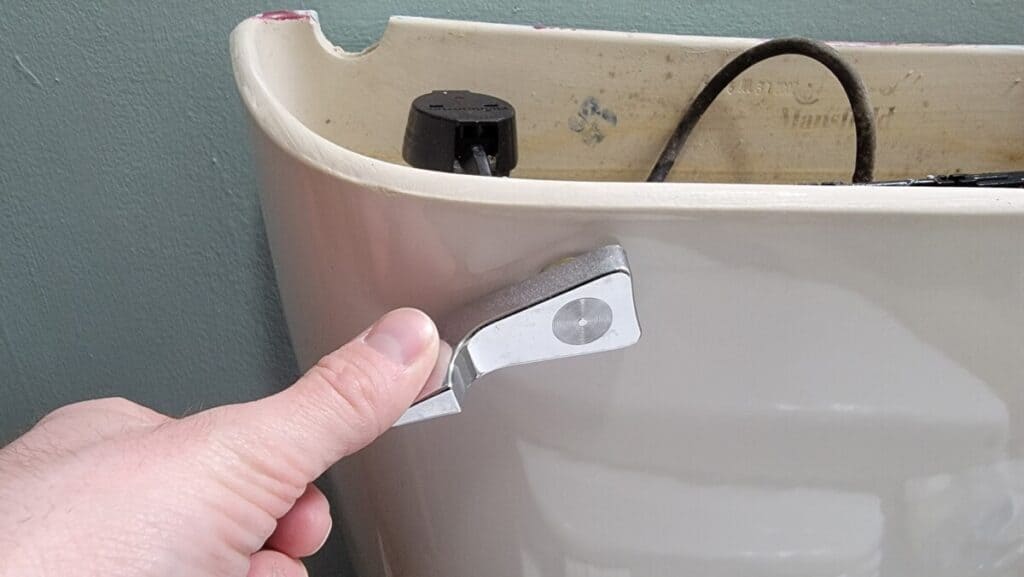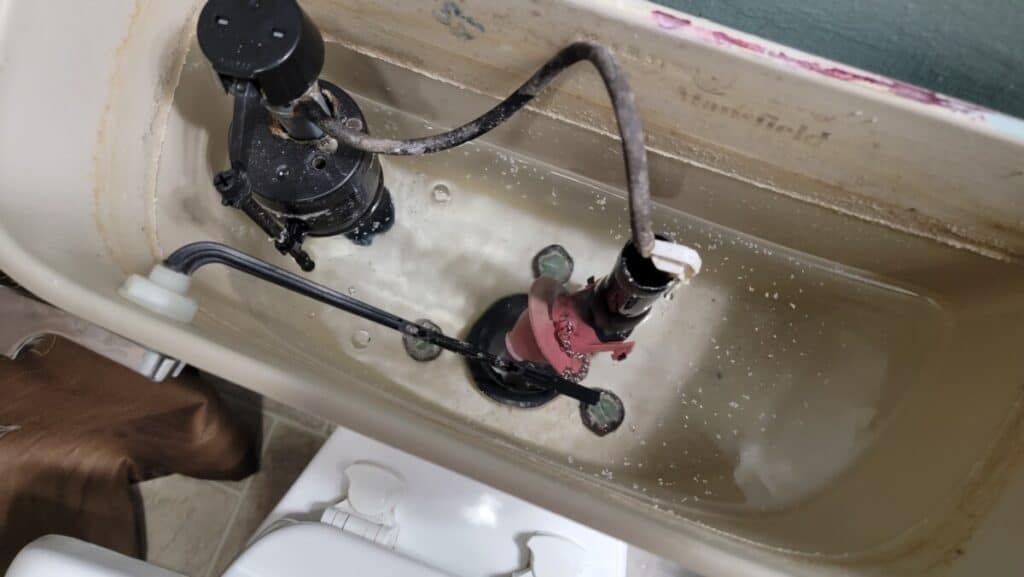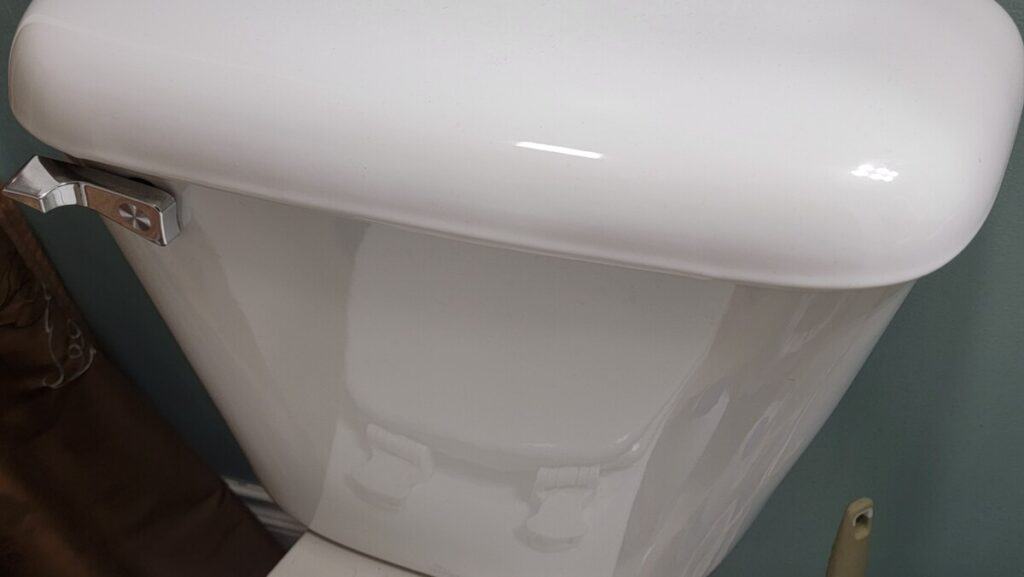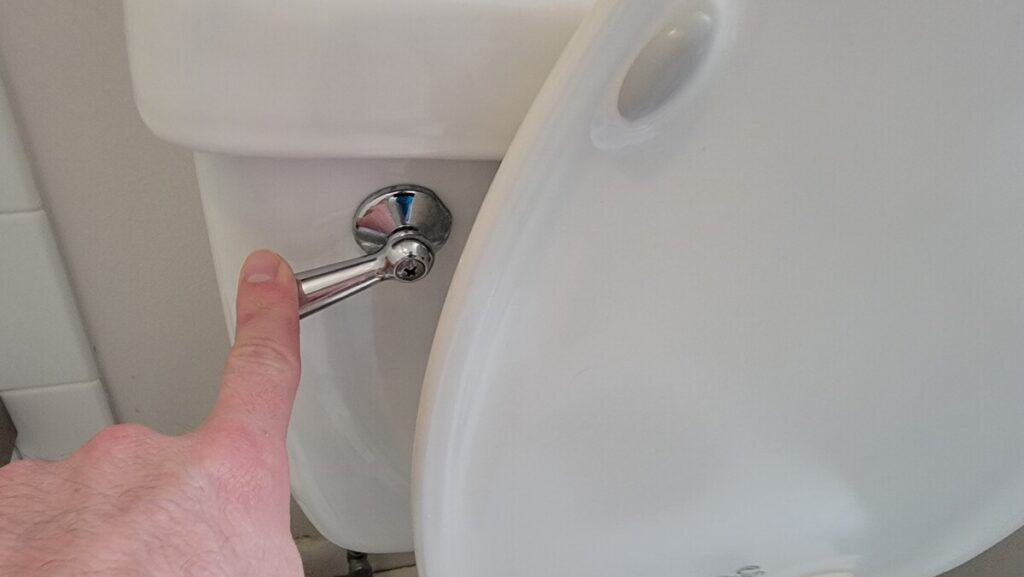To Caulk or Not to Caulk: Ultimate Guide to Toilet Sealing
Caulking around a toilet is a practice that has been around for a long time and it is still relevant today. When you install a toilet, it leaves open space between the floor and the base of the fixture. Caulking involves filling in this gap with some sealant material such as silicone or latex.
There are several reasons why you should consider caulking around your toilet. One of the main reasons to caulk around your toilet is to prevent water from other bathroom sources (or a flooding toilet) from seeping under the base of the toilet itself.
If there are any cracks or gaps between the base of the toilet and your bathroom floor, water can seep through and cause serious damage and odors over time. This can lead to mold growth, rotting wood in the floors, and even structural damage if you don’t catch it fast enough.
By caulking around your toilet, you create a watertight seal that prevents any moisture from leaking underneath.
Another important reason to consider caulking around your toilet is that it helps to keep unpleasant odors at bay.
When waste materials get trapped in between spaces under or behind toilets, they can emit foul smells that linger in bathrooms and affect indoor air quality. Caulking effectively seals these spaces and prevents bad odors from escaping into your bathroom. Any waste materials will remain on the perimeter of the toilet base and can be cleaned up accordingly.
Caulking also adds an aesthetic appeal to your bathroom by creating clean lines between the base of the toilet and the floor. It eliminates unsightly gaps and crevices that often collect dirt, dust, debris, human or pet hair which could be quite hard to clean making them breeding grounds for germs or pests. If your toilet isn’t caulked, just run a damp paper towel along the edge and you’ll see exactly what I mean.
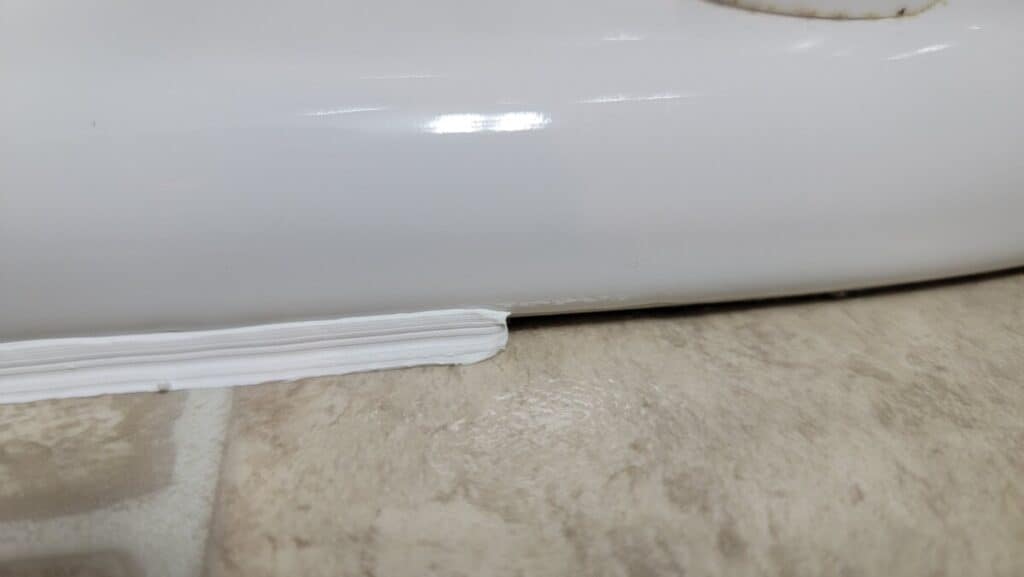
The Debate: To Caulk or Not to Caulk?
Caulking around a toilet seems like a necessary step while installing a new one or during home maintenance. Still, there is an ongoing debate among homeowners and plumbers about whether caulking around a toilet is necessary or not. There are pros and cons to both sides of the argument.
Proponents of caulking believe that it provides an additional layer of protection against water damage from outside sources (or an overflowing toilet bowl).
Water can easily seep through the small gap between the floor and toilet base, causing damage to subflooring or even ceiling stains in the room below. Caulk acts as a sealant to prevent water from penetrating these cracks and therefore protects your bathroom’s structural integrity.
On the other side of the coin, opponents of caulking argue that it causes more harm than good. One of their main concerns is related to the damage and hygiene issues caused by trapped water under the caulked area from a leak at the toilet’s wax ring itself. Without proper visibility, you might not catch leaks early on which could cause major repairs down the line.
Over time, if there is a leak under the toilet’s base, bacteria and mold can grow in this stagnant water leading to unpleasant odors and health hazards such as allergies or asthma. The floor can also become damaged, wood can rot, and ceilings or floors beneath the bathroom will experience leaks. Moreover, removing old caulk can become challenging when you need to replace your toilet.
Deciding whether or not you should caulk around your toilet depends on various factors including personal preference, bathroom design layout, and plumbing conditions in your home.
Regardless of what camp you find yourself in, you’re likely going to be mandated to caulk around the toilet due to local building codes.
The 2021 International Plumbing Code states the following:
Joints formed where fixtures come in contact with walls or floors shall be sealed.
Sept. 2021 International Plumbing Code

The following sections will explore how to properly caulk your toilet if you choose to do so along with practical tips on how to avoid common mistakes while providing detailed instructions for successful execution thereof.
How to Properly Caulk Around a Toilet: Step-by-Step Guide
Caulking around a toilet is not a difficult process — it just requires some preparation and attention to detail. The following is a step-by-step guide on how you can properly caulk around your toilet.
- The first step in caulking your toilet is to gather all the necessary tools and equipment. You will need a caulk gun, caulk remover tool, utility knife or razor blade, silicone or latex-based caulk suitable for use in bathrooms, and painter’s tape.
- Next, you should clean the area around your toilet thoroughly. Use a cleaning solution and scrub brush to remove any dirt, grime or old caulk that may be present. I even use some rubbing alcohol and a paper towel at the end to wipe everything down to make sure there is no oily or greasy residue left where I will be placing the caulk since it won’t adhere properly otherwise.
- Wipe the surface dry with a towel before proceeding further. Before applying new caulk around your toilet bowl base, place strips of painter’s tape on both sides of the intended caulking line. This will keep the line straight and prevent excess caulking from spilling over onto other areas.
- Using the caulk gun loaded with silicone or latex-based caulking material that is suitable for use in bathrooms carefully apply an even layer of caulk along the gap between the base of your toilet bowl and the floor surface. Be sure to apply enough pressure as you go along so that there are no gaps left uncovered by caulking material. I generally wet my finger and use my finger to gently press the silicone or caulk bead into the crevice and look uniform in appearance. Avoid applying too much pressure (with the caulk gun or your finger) as this can lead to an uneven line or too much excess material being pushed out which can be messy and difficult to clean up later.
- After applying caulking material all around your toilet bowl base allow it enough time (usually 24-48 hours) for it to dry completely before removing any painter’s tape or touching it again. After drying (curing) time has elapsed remove the painters’ tape slowly by pulling each strip at an angle away from where you had applied them earlier until they come out cleanly without leaving any marks behind on either side of the newly applied caulking line.
Types of Caulk Suitable for Toilets
When it comes to caulking around your toilet, choosing the right type of caulk is crucial. Not all caulks are made equal, and using the wrong one can lead to problems such as cracking, peeling, or mildew buildup.
Silicone Caulk
One of the most popular types of caulk for toilets is silicone caulk. It’s a flexible material that adheres well to different surfaces and lasts longer than other types of caulks.
Silicone caulk is also resistant to moisture and humidity, which makes it an excellent choice for bathrooms. However, silicone caulk can be challenging to apply evenly because it requires a steady hand and patience.
It’s also more expensive than other types of caulks on the market.
Acrylic Latex Caulk
Acrylic latex caulk is another common type used for sealing gaps around toilets. It’s easy to apply, dries quickly, and doesn’t shrink or crack over time.
Acrylic latex caulk is also paintable once it’s fully cured. However, acrylic latex caulks are not as durable as silicone caulks when exposed to water or moisture over time.
Hybrid Polymer Caulk
Hybrid polymer caulk combines the best features of silicone and acrylic latex caulks into one product.
This type of caulk is flexible, durable, waterproof, paintable once cured and has a long lifespan. Hybrid polymer caulks don’t release harmful VOCs (volatile organic compounds) making them eco-friendly options.
While hybrid polymer caulking products may be more expensive than other options in this list when you think about their longevity they have been proven to provide better value over time.
Choosing suitable toilet sealant involves weighing several factors such as durability against moisture or humidity levels in your bathroom. You’ll need to consider the space, ease-of-application, drying times, and cost-effectiveness — all while ensuring that your choice is eco-friendly. By considering these factors, you can ensure that you pick the right type of caulk for your toilet and prevent any problems down the line.
The Role of Caulking in Preventing Odors
While many people might consider caulking around a toilet as an optional cosmetic detail, it can actually play an essential role in preventing unpleasant odors from permeating your bathroom. When installed correctly, toilet caulk can act as a barrier between the base of the toilet and the floor, eliminating any gaps that could allow sewage gases to escape (if you have a compromised wax ring) and circulate throughout your home.
Moreover, the gases that emanate from a toilet’s base are not only unpleasant but also potentially harmful. Sewage gases contain methane, which is highly flammable and can cause explosions when it accumulates in enclosed spaces.
Additionally, these gases contain carbon dioxide and hydrogen sulfide which can be dangerous if inhaled excessively. Caulking around your toilet is not only beneficial for preventing odors but also essential for maintaining good air quality within your home.
The elimination of gaps between the floor and the base of your toilet will also prevent any unwanted water from the shower or an overflowing toilet from getting under the toilet base and turning into a breeding ground for smelly bacteria.
How Caulking Helps in Securing the Toilet
Caulking around a toilet is not only essential for aesthetics but also for the security of the toilet. A well-sealed caulk line ensures that there are no spaces between the toilet base and the floor that may allow water to leak or seep in beneath the toilet.
Water leaks near a toilet may lead to significant problems if left unaddressed, such as water damage, mold growth, or even structural instability. Caulking helps secure your toilet and ensures that it stays in place.
One key factor in securing your toilet is by preventing any wobbling or shifting from its position on the floor. If your toilet is not anchored securely to the floor, it can cause significant issues over time, including water damage and leakage.
If you happen to have a wobby or shifty toilet seat and not the toilet base itself, you can check out how to fix that problem here.
Caulking can help prevent this issue by providing additional support and stability around the base of your toilet. Another way caulking helps secure your toilet is by preventing unwanted movement caused by heavy usage or vibration.
A well-sealed caulk line will provide an extra layer of resistance against any movement that may cause damage to your plumbing system. This extra layer of support also helps prevent mechanical stress on critical components like bolts and seals.
Caulking provides a barrier against insects and other pests from entering through small openings under your toilets’ base, which can ultimately lead to infestations inside your bathroom walls or floors. The presence of these pests can be stressful and hazardous to you and your family’s health.
Caulking around a toilet plays an essential role in securing it firmly to its location on the floor while preventing water leaks, vibrations caused by heavy usage, mechanical stress on bolts and seals as well as insects’ infestation chances. Therefore, it is crucial to ensure proper sealing with high-quality caulk material when installing or maintaining a bathroom’s plumbing system.
Common Mistakes to Avoid When Caulking Around a Toilet
Caulking around a toilet may seem like a simple task, but it can be easy to make mistakes. These common mistakes can lead to water damage, leaks, and bad odors.
In this section, we will discuss the common mistakes people make when caulking around a toilet and how to avoid them. One of the most common mistakes people make when caulking around a toilet is not cleaning the area properly before applying the caulk.
Dirt, dust, and debris can prevent proper adhesion of the caulk and cause it to fail over time. To avoid this mistake, thoroughly clean the area around the toilet with a mild cleaner, or soap and water.

Make sure to dry the area completely before applying any caulk, and I usually take a rag with rubbing alcohol and wipe around the edge of the base as well to remove any missed greases or oils that will prevent the caulk from adhering properly.
Another mistake is not using enough caulk or using too much in one area.
Using too little caulk will result in gaps that may allow water to seep through while using too much will cause the excess to squish out from under the toilet base and create an unsightly mess on your floor. To avoid this mistake, apply a continuous bead of caulk that covers all gaps between your toilet base and floor but be careful not to apply too much pressure.
Many people make the mistake of painting over wet caulking without allowing it sufficient time for drying. Painting over wet caulking will lead to unevenness which leads to an unprofessional look on your finished wall or floor.
Always wait 24-48 hours for your caulking to dry (cure) completely before attempting any further work on it such as painting or sealing (not to mention just sitting on the toilet before it has fully cured). Taking care not to repeat these common mistakes when caulking around your toilet will ensure that you have a long-lasting seal that protects against leaks and bad odors while remaining an aesthetically pleasing addition in your bathroom’s decor style.
How to Maintain and Clean Caulk Around a Toilet
Maintaining and cleaning the caulk around your toilet is crucial to ensure it remains effective in preventing leaks and trapping odors. Here are some tips on how to maintain and clean the caulk around your toilet: To maintain caulk around your toilet, it is important to keep it dry.
After every use of the bathroom, use a towel or cloth to wipe down any excess water that may be on the surface of the caulk. This will prevent mildew and mold from growing on the surface of the caulk.
For any orange or pink stains that won’t come out from water being on the caulk for too long, I have always used Mold Armour Rapid Clean Remediation (Amazon). When we discovered this product when doing maintenance, it was a game changer for bathroom touch ups. Just spray on the stain, walk away, and come back 5 minutes later. It will be perfectly new looking again. You can then wipe up any excess that remains on the caulk. It works great for stains in baths and showers as well!
Overall, regularly maintaining and cleaning caulk around your toilet will prolong its lifespan and effectiveness in preventing leaks and trapping odors. It’s also important to note that if you notice any cracks or gaps in the caulking, it’s best to reapply new caulking as soon as possible to prevent any potential water damage or mold growth.
Final Takeaways
After carefully considering the various pros and cons of caulking around your toilet, it is safe to say that caulking can be a beneficial addition to any bathroom. By code, it’s usually required.
Caulk serves not only as a sealant but also provides a neat and tidy appearance. It helps prevent water damage, mold growth, and reduces the risk of structural damage.
The use of high-quality caulk applied skillfully and correctly will ensure that there are no gaps for water or dirt to seep through. The result is a more hygienic bathroom with less chance for unpleasant odors or bacteria growth.
To get the most out of your caulking efforts, it is essential to choose the right type of caulk for your needs. Silicone caulk is an excellent choice due to its flexibility and water-resistant properties.
Make sure you regularly inspect your caulking around the toilet for any wear or damage. A well-maintained caulk seal will offer many years of protection against leaks and other potential issues.
If you are considering whether or not to caulk around your toilet, it’s important to keep in mind all the benefits that come with proper installation. With proper precautions in place, such as using high-quality materials and regular inspections/maintenance, caulking can help you maintain a clean and hygienic bathroom environment while also protecting against potential damages from moisture or other factors.




